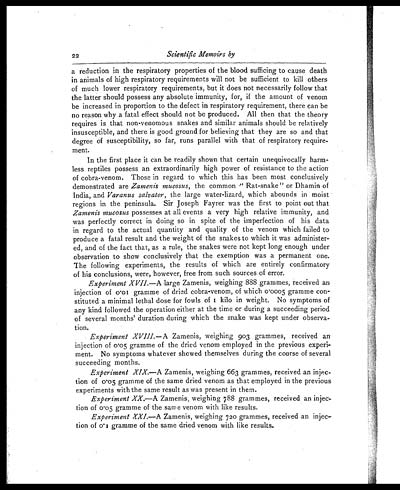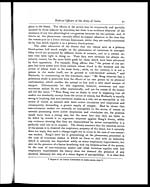Medicine - Institutions > Army health reports and medical documents > Scientific memoirs by medical officers of the Army of India > Part IX, 1895 > 1 - Physiological action of snake-venom
(28) Page 22
Download files
Individual page:
Thumbnail gallery: Grid view | List view

22
Scientific Memoirs by
a reduction in the respiratory properties of the blood sufficing to cause death
in animals of high respiratory requirements will not be sufficient to kill others
of much lower respiratory requirements, but it does not necessarily follow that
the latter should possess any absolute immunity, for, if the amount of venom
be increased in proportion to the defect in respiratory requirement, there can be
no reason why a fatal effect should not be produced. All then that the theory
requires is that non-venomous snakes and similar animals should be relatively
insusceptible, and there is good ground for believing that they are so and that
degree of susceptibility, so far, runs parallel with that of respiratory require-
ment.
In the first place it can be readily shown that certain unequivocally harm-
less reptiles possess an extraordinarily high power of resistance to the action
of cobra-venom. Those in regard to which this has been most conclusively
demonstrated are Zamenis mucosus, the common. "Rat-snake" or Dhamin of
India, and Varanus salvator, the large water-lizard, which abounds in moist
regions in the peninsula. Sir Joseph Fayrer was the first to point out that
Zamenis mucosus possesses at all events a very high relative immunity, and
was perfectly correct in doing so in spite of the imperfection of his data
in regard to the actual quantity and quality of the venom which failed to
produce a fatal result and the weight of the snakes to which it was administer-
ed, and of the fact that, as a rule, the snakes were not kept long enough under
observation to show conclusively that the exemption was a permanent one.
The following experiments, the results of which are entirely confirmatory
of his conclusions, were, however, free from such sources of error.
Experiment XVII .—Marge Zamenis, weighing 888 grammes, received an
injection of 0.01 gramme of dried cobra-venom, of which 0.0005 gramme con-
stituted a minimal lethal dose for fowls of 1 kilo in weight. No symptoms of
any kind followed the operation either at the time or during a succeeding period
of several months' duration during which the snake was kept under observa-
tion.
Experiment XVIII.—A Zamenis, weighing 903 grammes, received an
injection of 0.05 gramme of the dried venom employed in the previous experi-
ment. No symptoms whatever showed themselves during the course of several
succeeding months.
Experiment XIX.—A Zamenis, weighing 663 grammes, received an injec-
tion of 0.05 gramme of the same dried venom as that employed in the previous
experiments with the same result as was present in them.
Experiment XX.—A Zamenis, weighing 788 grammes, received an injec-
tion of 0.05 gramme of the same venom with like results.
Experiment XXI.—A Zamenis, weighing 720 grammes, received an injec-
tion of 0.1 gramme of the same dried venom with like results.
Set display mode to: Large image | Zoom image | Transcription
Images and transcriptions on this page, including medium image downloads, may be used under the Creative Commons Attribution 4.0 International Licence unless otherwise stated. ![]()
| Permanent URL | https://digital.nls.uk/75002491 |
|---|
| Shelfmark | IP/QB.10 |
|---|---|
| Additional NLS resources: | |




